中西方传统节日文化差异英语
- 格式:ppt
- 大小:4.31 MB
- 文档页数:7
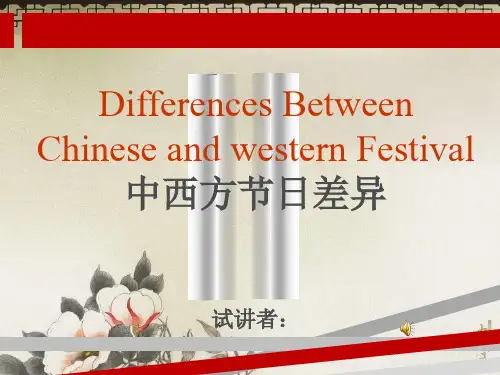

Culture Differences of Chinese and Western TraditionalFestivalsIntroductionCulture is the soul carrier of human beings, and it’s the core value of one country. Different countries have different cultures. Among all the elements that consist a nation’s culture, traditional festival culture is the most essential and richest one. As we all know, Chinese and western traditional festivals are two different cultural forms evolved from comparatively independent cultural systems, which possess peculiar characteristics and varied manifestation. So there must be lots of differences. Through comparing Chinese Spring Festival with Western Christmas Day, Tomb Sweeping Day with Halloween, Double-Seventh Day with Valentines’Day, Mid-autumn Festival with Thanks Giving Day, this thesis tries to find out and make a rough analysis on the similarities and cultural differences between Chinese and Western countries.The thesis consists of four parts. The first part would focus on the main important traditional festivals both in China and western countries. After brief introduction in the form of comparison to the main festivals, there would be an analysis on the similarities and differences of traditional Chinese and western festivals in the second and third parts. In the last part of the thesis, there would be a brief conclusion.Key words:Traditional festivals; Chinese and western culture; different cultural .ContentsIntroduction1. Important Traditional Festivals in China and Western Countries Respectively1.1 Spring Festival vs. Christmas Day1.2 Tomb Sweeping Day vs. Halloween1.3 Double-Seventh Day vs. Valentine’s Day1.4 Mid-autumn Day vs. Thanksgiving Day2. Common ground of traditional Chinese and western festivals 2.1 Similarities in perspective of the functions of the festivals3. Differences of traditional Chinese and western festivals 3.1 The differences in perspective of forms3.2 Difference in perspective of inner meaning4. ConclusionReferences1.Important Traditional Festivals in China and Western Countries Respectively1.1 Spring Festival vs. Christmas DayThese two are the most important festivals in their own cultural systems. The Spring Festival is the chief holiday in China while Christmas is the most important red-letter day in the western world. People attach great attention to the celebration of these two festivals.The Spring Festival is the most important festival for the Chinese people and it is an occasion for all family members to get together, just like Christmas in the West. All people living away from home go back to enjoy the family reunion. The Spring Festival falls on the 1st day of the 1st lunar month, often one month later than the Gregorian calendar. But strictly speaking, the Spring Festival starts every year in the early days of the 12th lunar month and will last till the mid 1st lunar month of the next year. Of them, the most important days are Spring Festival Eve and the first three days.Many customs accompany the Spring Festival. For example: On the 8th day of the 12th lunar month, many families make laba porridge. The 23rd dayof the 12th lunar month is called Preliminary Eve. People usually offer sacrifice to the kitchen god on this day. Most families make delicious food to enjoy themselves nowadays. After the Preliminary Eve, people begin preparing for the coming New Year. This is called "Seeing the New Year in". Before the New Year comes, people completely clean their homes as well as their clothes, utensils, etcs. Then people begin decorating their clean rooms featuring an atmosphere of rejoicing and festivity. All the door panels will be pasted with Spring Festival couplets, highlighting Chinese calligraphy with black characters on red paper. The content varies from house owners' wishes for a bright future to good luck for the New Year. Also, pictures of the god of doors and wealth will be posted on front doors to ward off evil spirits and welcome peace and abundance.Christmas Day is a holiday held on December 25 to commemorate the birth of Jesus, the central figure of Christianity, even though the date is not known to be the actual birth date of Jesus. Although nominally a Christian holiday, Christmas is also widely celebrated by many non-Christians, and many of its popular celebratory customs have pre-Christian or secular themes and origins. Popular modern customs of the holiday include gift-giving, music, an exchange of greeting cards, church celebrations, a special meal, and the display of various decorations, including Christmas trees, lights, garlands, etcs. In addition, Father Christmas (or Santa Claus) is a popular folklore figure in many countries, associated with the bringing of gifts for children.Christmas Day is celebrated as a major festival and public holiday in most countries of the world, even in many whose populations are not Christian majorities. In some non-Christian countries or areas such as Hong Kong, former colonial rules are introduced to the celebration, Christian minorities or foreign cultural influences have led populations to observe the holiday. Around the world, Christmas celebrations can vary greatly in form, reflecting different cultural and national traditions. Countries such as Japan and Korea, where Christmas is popular despite there being only a small number of Christians, have adopted many of the secular aspects of Christmas, such as gift-giving, decorations and Christmas trees.1.2 Tomb Sweeping Day vs. HalloweenTomb Sweeping Day and Halloween are two different festivals which have the similar functions. They are celebrated in China and mainly America respectively. Both of them are festivals for commemorating the dead people.Tomb Sweeping Day is one of the few traditional Chinese holidays that follows the solar calendar—typically falling on April 4, 5, or 6. Its Chinese name "Qing Ming" literally means "Clear Brightness," hinting at its importance as a celebration of Spring. Similar to the festivals of spring in the other cultures, Tomb Sweeping Day celebrates the rebirth of nature, while marking the beginning of the planting season and other outdoor activities.In ancient times, people celebrated Tomb Sweeping Day with dancing, singing, picnics, and kite flying. Colored boiled eggs would be broken to symbolize the opening of life. In the capital, the Emperor would plant trees on the palace grounds to celebrate the renewing nature of spring. In the villages, young men and women would court each other. With the passing of time, this celebration of life became a day to the honor past ancestors. Following folk religion, the Chinese believed that the spirits of deceased ancestors looked after the family. Sacrifices of food and spirit money could keep them happy, and the family would prosper through good harvests and more children. Today, Chinese also visit their family graves to commemorate the ancestors on this day. Weeds are pulled, and dirt swept away, and the family will set out offerings of food and spirit money. Unlike the sacrifices at a family's home altar, the offerings at the tomb usually consist of dry, bland food.Halloween is an annual holiday celebrated on October 31. It has roots in the Celtic festival of Samhain and the Christian holy day of All Saints, but is today largely a secular celebration.Halloween is not celebrated in all countries and regions of the world, but among those that do have the traditions, the form of celebration vary significantly. Celebration in the United States has had a significant impact on how the holiday is observed in other nations. This larger American influence, particularly in iconic and commercial elements, hasextended to places such as South America, Europe, etcs.Halloween activities include trick-or-treating, wearing costumes and attending costume parties, carving jack-o'-lanterns, ghost tours, bonfires, apple bobbing, visiting haunted attractions, pranks, telling scary stories, and watching horror films.1.3 Double-Seventh Day vs. Valentine’s DayDouble-Seventh Day, also known as Magpie Festival, falls on the seventh day of the seventh lunar month on the Chinese calendar, thus its name. It is based on the story of the cowherd and the weaver girl whose true love moved magpies.Young girls traditionally demonstrate their domestic arts, especially melon carving, on this day and make wishes for a good husband. It is also known by the following names:The Festival to Plead for Skills (乞巧节)The Seventh Sister's Birthday (七姊诞)The Night of Skills (巧夕)Saint Valentine's Day (commonly shortened to Valentine's Day) is an annual commemoration held on February 14 celebrating love and affection between intimate companions. The day is named after one or more early Christian martyrs named Valentine and was established by Pope Gelasius I in 500 AD. It is traditionally a day on which lovers express their love for each other by presenting flowers, offering confectionery, and sending greeting cards (known as "valentines"). The day first became associated with romantic love in the circle of Geoffrey Chaucer in the High Middle Ages, when the tradition of courtly love flourished.Modern Valentine's Day symbols include the heart-shaped outline, doves, and the figure of the winged Cupid. Since the 19th century, handwritten valentines have largely given way to mass-produced greeting cards.1.4 Mid-autumn Day vs. Thanksgiving DayThe Mid-Autumn Festival, also known as the Moon Festival, Zhongqiu Festival, or in Chinese, Zhongqiujie, is a popular harvest festival celebrated by people in the Chinese influenced world, dating back over 3,000 years to moon worship in China's Shang Dynasty. It is also celebrated by the Vietnamese, Koreans, and Japanese in different forms. TheMid-Autumn Festival is held on the 15th day of the eighth month in the Chinese calendar, which is usually around late September or early October in the Gregorian calendar. The traditional food of this festival is the mooncake, of which there are many different varieties.The Mid-Autumn Festival is one of the few most important holidays in the Chinese calendar, and is a legal holiday in several countries. Farmers celebrate the end of the summer harvesting season on this date. Traditionally on this day, Chinese family members and friends will gather to admire the bright mid-autumn harvest moon, and eat moon cakes under the moon together.Thanksgiving or Thanksgiving Day is a harvest festival celebrated primarily in the United States and Canada. Traditionally, Thanksgiving is associated with giving thanks to God for the harvest and expressing gratitude. While historically religious in origin, Thanksgiving is now primarily identified as a secular holiday.In the United States, Thanksgiving is usually celebrated on the fourth Thursday in November and has been an annual tradition in the United States since 1863.In Canada Thanksgiving occurs on the second Monday in October and is an annual Canadian holiday to give thanks at the close of the harvest season.mon ground of traditional Chinese and western festivalsThrough the introduction to the main important festivals of the two cultural systems in pairs, the points that can be compared are quite obvious. In the following parts of the thesis, there would be the analysis.2.1 Similarities in perspective of the functions of the festivalsNo matter the traditional Chinese festivals or the Western ones, the meaning and functions people attach on them are more or less the same. They express their good wishes for the happy life on festivals, and some very important festivals are celebrated for family reunion. The similarfunctions between the festivals of the two cultural systems can be listed as below.The yearning and pursuit for a happy and bliss life.The continuity of the traditional virtue and the respect to the dead people.The Desire for eternal love,The admiration of historical heroes.The occasions for family reunion.2.2 Similarities in perspective of the origins of the festivalsThe traditional Chinese and western festivals also have common points in the perspective of origins. They both celebrate for customs, although the customs may differ with each other. For example the Spring Festival and Christmas Day have their own customs, but people celebrate them every year. Some of them celebrate for the harvest such as the Chinese Mid-autumn Day and the Western Thanksgiving Day. Religion as a kind of ancient cultural phenomenon has a close relationship with all kinds of festivals both in China and western countries. So this can also be one part of the similarities of the origins of Chinese and western festivals.3.Differences of traditional Chinese and western festivalsAlthough there are many similarities between traditional Chinese and western festivals, there are still lots of differences because the natural environment, historical background and the cultural atmosphere out of which the festivals were formed are different. The main differences can be listed as follows:3.1 The differences in perspective of formsThey have different periodicity. Chinese traditional festivals are mainly based on lunar calendar, while the western ones are mainly based on the solar calendar.The influential areas of the two sets of festival cultures are different. Chinese festivals mainly influence the Asian countries including Japan,Korean, Thailand, etc. The western festivals mainly influence the Christian world. Although in the modern multi-cultural world the influences of western festivals such as Christmas Day are much wider than Chinese Spring Festival, the traditions which have been formed in many countries still exist.3.2 Difference in perspective of inner meaningChinese and western countries have different background of traditional festival culture. The traditional Chinese festival cultures are under the background of farming culture, while the traditional western festival cultures are under the background of Christianity.They also have different contents of festival culture. Traditional Chinese festival cultures are featured by food and wine. While traditional western festival cultures are featured by entertainment.The next difference in the perspective of inner meaning is that they have different value orientation. Traditional Chinese festival cultures are featured by collectivism. Chinese festivals attach more importance to group activity and the passing down of ethics and virtues. But traditional western festival cultures are featured by individualism. They lay great emphasis on the expression of personal emotions and the individual psychological feelings.The national culture mentality can also be different. The Chinese festival culture are Comedy-oriented, they pursuit the happy ending and harmony, while the western festival culture are tragedy-oriented because the ancient Greek culture are tragic-conscious and the Christian culture are sin conscious.4.ConclusionBased on the previous analysis and comparison, we can learn that China and western countries have two different sets of cultural systems which originate from different natural and social environments, and also from different historical development process. They have different features although there are lots of common grounds.Under the current multi-cultural world where Chinese and westernfestivals encounter and integrate with each other, we, as English majors who learn cultures need to adhere to the spirit of our own culture, meanwhile, we need to reveal the intrinsic value of the Chinese and Western traditional festivals from the perspective of modern concepts.References[1]Li Ziyin. from the traditional festival of Chinese and western cultural differences [J], science and education wenhui. 2007 (4)[2] Fang jersey. The comparison of Chinese and western traditional culture festival [M], Shan Dong university, master's degree thesis.[3] Li Mi . Chinese and western festival contrast research [J], Yue Yang vocational and technical college school. 2006 (3)[4] Wang Ju’e. Under the cross-cultural perspective of China's Chinese valentine's day and western valentine's day [J], xi 'an college of liberal arts school. 2009 (6)。
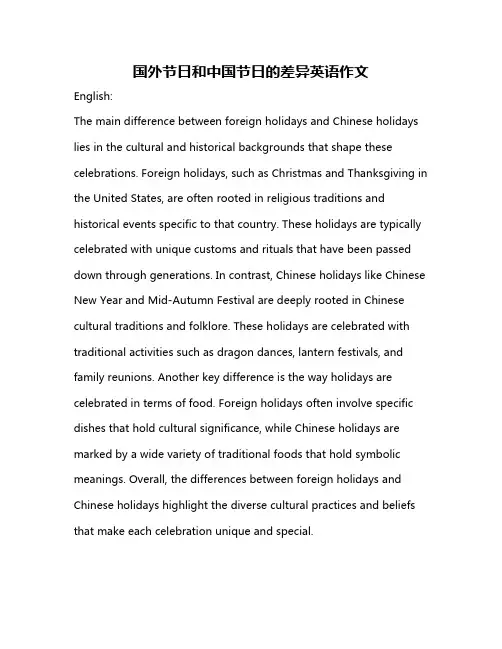
国外节日和中国节日的差异英语作文English:The main difference between foreign holidays and Chinese holidays lies in the cultural and historical backgrounds that shape these celebrations. Foreign holidays, such as Christmas and Thanksgiving in the United States, are often rooted in religious traditions and historical events specific to that country. These holidays are typically celebrated with unique customs and rituals that have been passed down through generations. In contrast, Chinese holidays like Chinese New Year and Mid-Autumn Festival are deeply rooted in Chinese cultural traditions and folklore. These holidays are celebrated with traditional activities such as dragon dances, lantern festivals, and family reunions. Another key difference is the way holidays are celebrated in terms of food. Foreign holidays often involve specific dishes that hold cultural significance, while Chinese holidays are marked by a wide variety of traditional foods that hold symbolic meanings. Overall, the differences between foreign holidays and Chinese holidays highlight the diverse cultural practices and beliefs that make each celebration unique and special.Translated content:国外节日和中国节日的主要区别在于塑造这些庆祝活动的文化和历史背景。

Culture Differences of Chinese and Western TraditionalFestivalAbstractTraditional festivals are the historical products of a nation’s development. Whether in China which has a long history of more than five thousand years or in the newborn America, the origination of traditional festivals in the two countries is similar. Most traditional festivals originated from people’s expectation for harvest in the agricultural production, the worship towards the gods and the nature, sacrifices to the historical characters and etc. After the long-term evolution, traditional festivals have become an indispensable part of the national culture. Through traditional festivals, the distinct cultural characteristics of a people and the national spirits can be observed. Since the ancient time, China has been a large agricultural country, the small-scale economic mode known as “The men plough and the women weave” initiated the agricultural civilization of Chinese characteristics. Chinese traditional festivals are deeply rooted in the agricultural civilization and greatly influenced by Confucianism. To some extent, Chinese traditional festivals have relieved from the primitive taboos and tended to be happy festivals which reflect the concept of harmony and integration in Confucianism. In America, religion plays a very important role in people’s life. With various branches, the religious system of America is quite complicated, among which Christianity is of the greatest importance. Some American traditional festivals are the direct products of Christianity and most festivals haveevolved into the religious festivals later. This paper is designed to discuss the differences in customs, origins and other aspects of traditional festivals with the similar cultural connotation, then analyze the reasons lying behind the differences and finally reflect the cultural differences of the two nations. The paper also analyzes the mutual fusion in tradtional holidays between China and the west.Key words: Traditional festivals; Chinese and American culture; cultural differences; causes; mutual fusion.中西方传统节日文化的差异摘要传统节日是一个民族发展的历史产物。
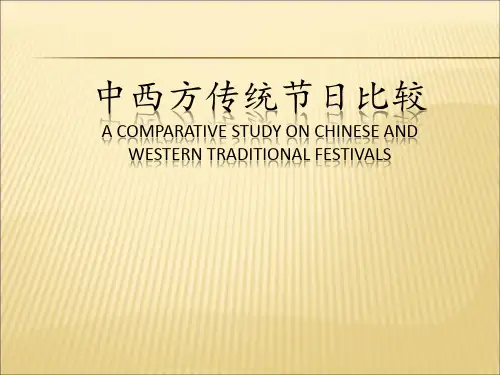

Culture Differences of Chinese and Western TraditionalFestivalAbstractTraditional festivals are the historical products of a nation’s development. Whether in China which has a long history of more than five thousand years or in the newborn America, the origination of traditional festivals in the two countries is similar. Most traditional festivals originated from people’s expectation for harvest in the agricultural production, the worship towards the gods and the nature, sacrifices to the historical characters and etc. After the long-term evolution, traditional festivals have become an indispensable part of the national culture. Through traditional festivals, the distinct cultural characteristics of a people and the national spirits can be observed. Since the ancient time, China has been a large agricultural country, the small-scale economic mode known as “The men plough and the women weave” initiated the agricultural civilization of Chinese characteristics. Chinese traditional festivals are deeply rooted in the agricultural civilization and greatly influenced by Confucianism. To some extent, Chinese traditional festivals have relieved from the primitive taboosand tended to be happy festivals which reflect the concept of harmony and integration in Confucianism. In America, religion plays a very important role in people’s life. With various branches, the religious system of America is quite complicated, among which Christianity is of the greatest importance. Some American traditional festivals are the direct products of Christianity and most festivals have evolved into the religious festivals later. This paper is designed to discuss the differences in customs, origins and other aspects of traditional festivals with the similar cultural connotation, then analyze the reasons lying behind the differences and finally reflect the cultural differences of the two nations. The paper also analyzes the mutual fusion in tradtional holidays between China and the west.Key words: Traditional festivals; Chinese and American culture; cultural differences; causes; mutual fusion.中西方传统节日文化的差异摘要传统节日是一个民族发展的历史产物。
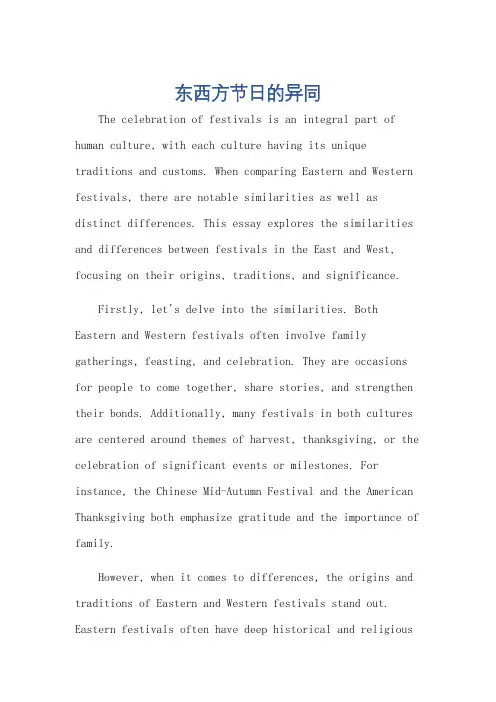
东西方节日的异同The celebration of festivals is an integral part of human culture, with each culture having its unique traditions and customs. When comparing Eastern and Western festivals, there are notable similarities as well as distinct differences. This essay explores the similarities and differences between festivals in the East and West, focusing on their origins, traditions, and significance.Firstly, let's delve into the similarities. Both Eastern and Western festivals often involve family gatherings, feasting, and celebration. They are occasions for people to come together, share stories, and strengthen their bonds. Additionally, many festivals in both cultures are centered around themes of harvest, thanksgiving, or the celebration of significant events or milestones. For instance, the Chinese Mid-Autumn Festival and the American Thanksgiving both emphasize gratitude and the importance of family.However, when it comes to differences, the origins and traditions of Eastern and Western festivals stand out. Eastern festivals often have deep historical and religiousroots. For example, the Chinese Spring Festival, also known as the Chinese New Year, is a festival with over 4000 years of history, rooted in ancient agricultural traditions andthe lunar calendar. It's a time for family reunions, fireworks, and the giving of red envelopes as symbols of good luck and prosperity. Similarly, the Indian Diwali, a festival of lights, is a celebration of good over evil anda symbol of hope and renewal.On the other hand, Western festivals often have more secular origins, with many of them evolving from pagan customs or historical events. Christmas, for instance,while now celebrated as a religious holiday by Christians, originated from pagan festivals marking the winter solstice. It's now associated with gift-giving, festive decorations, and the iconic figure of Santa Claus. The American Independence Day, on the other hand, commemorates a significant historical event - the Declaration of Independence from Great Britain.Another significant difference lies in the celebration styles. Eastern festivals tend to be more festive andlively, with vibrant colors and loud celebrations. The useof fireworks, dragon dances, and other lively performances are common during festivals like the Chinese New Year or the Indian Holi. In contrast, Western festivals may have a more subdued tone, emphasizing the spirit of giving, reflection, and gratitude. Christmas, for example, is a time for quiet family gatherings, singing carols, and exchanging gifts.Furthermore, the foods associated with these festivals also differ greatly. Eastern festivals often feature a range of traditional dishes that are unique to the culture. Dumplings, spring rolls, and mooncakes are staples of Chinese festivals, while Indian festivals might include sweets like ladoos and jalebis. Western festivals, on the other hand, might involve more of a mix of traditional and non-traditional foods. Christmas, for instance, is knownfor its roast turkey, mince pies, and Christmas pudding, while Thanksgiving is centered around a feast of roasted meats, potatoes, and pies.In conclusion, while Eastern and Western festivals share some similarities in terms of their purpose and the spirit of celebration, they differ significantly in theirorigins, traditions, and celebration styles. These differences reflect the rich cultural diversity of theworld and make each festival unique and memorable. As we continue to learn and appreciate these differences, we gain a deeper understanding of the various cultures andtraditions that make up our global community.**东西方节日的异同**节日的庆祝是人类文化的重要组成部分,每种文化都有自己独特的传统和习俗。
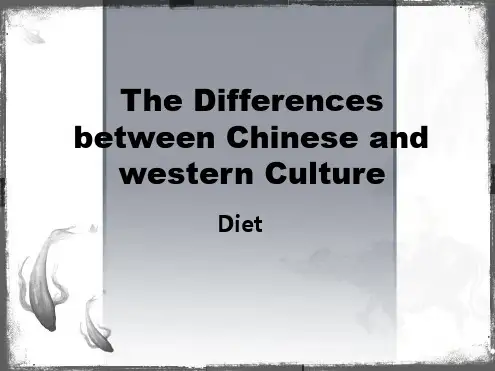
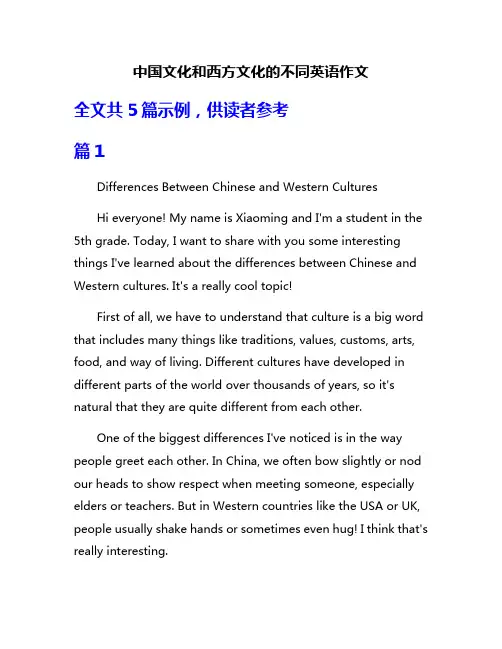
中国文化和西方文化的不同英语作文全文共5篇示例,供读者参考篇1Differences Between Chinese and Western CulturesHi everyone! My name is Xiaoming and I'm a student in the 5th grade. Today, I want to share with you some interesting things I've learned about the differences between Chinese and Western cultures. It's a really cool topic!First of all, we have to understand that culture is a big word that includes many things like traditions, values, customs, arts, food, and way of living. Different cultures have developed in different parts of the world over thousands of years, so it's natural that they are quite different from each other.One of the biggest differences I've noticed is in the way people greet each other. In China, we often bow slightly or nod our heads to show respect when meeting someone, especially elders or teachers. But in Western countries like the USA or UK, people usually shake hands or sometimes even hug! I think that's really interesting.Another major difference is in our foods. Chinese cuisine is known for its delicious flavors and use of ingredients like rice, noodles, soy sauce, and tea. We also love to eat with chopsticks! On the other hand, Western foods are often based on bread, meat, cheese, and wine. Their eating utensils are usually forks, knives, and spoons.Family values are also quite different. In Chinese culture, we have a strong emphasis on respecting and taking care of our elders, like grandparents. Children are expected to obey their parents and work hard in school to bring honor to the family. But in many Western cultures, children are encouraged to be more independent and make their own choices from a young age.Speaking of school, the education systems are quite different too! In China, we have strict discipline and a lot of emphasis on exams and scores. Students often stay late after school for extra classes or tutoring. But in Western schools, there is more focus on creativity, group projects, and overall development of the child.Holidays and festivals are another area where cultures differ a lot. In China, we celebrate events like Chinese New Year,Mid-Autumn Festival, and Dragon Boat Festival. These involve traditions like setting off firecrackers, eating mooncakes, anddragon boat racing. Western holidays like Christmas, Easter, and Thanksgiving have their own unique customs like decorating Christmas trees, egg hunting, and having big turkey dinners.I also find the differences in arts and crafts really fascinating. Chinese arts like calligraphy, paper cutting, and painting with ink brushes have been practiced for centuries. In contrast, Western arts are more focused on things like oil paintings, sculpting, and modern abstract art.Of course, these are just some of the many differences between our cultures. But I think it's amazing how diverse the world is, with so many rich traditions and ways of life. Learning about different cultures helps us appreciate and respect each other better.Even though we may do things differently, I believe all cultures have something valuable to offer. We should keep an open mind, be curious to learn from each other, and focus on the things that bring us together as human beings.I hope you found my essay interesting and informative. Let me know if you have any other thoughts or questions! Thanks for reading.篇2Hi,大家好!我是小明,今天我要给大家写一篇关于中国文化和西方文化不同的英语作文。
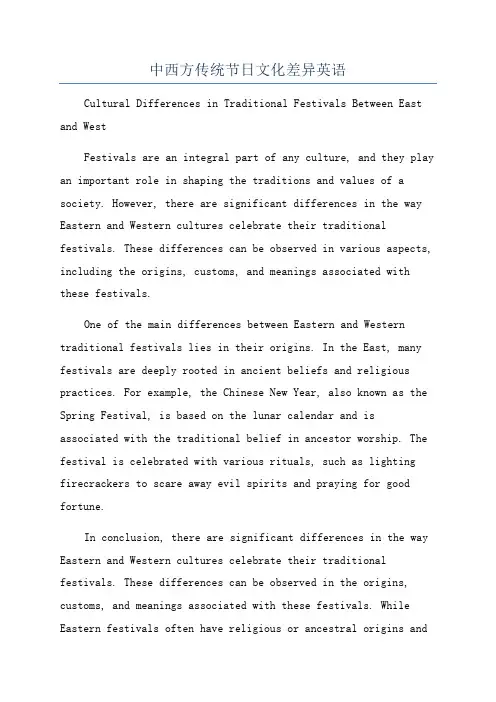
中西方传统节日文化差异英语Cultural Differences in Traditional Festivals Between East and WestFestivals are an integral part of any culture, and they play an important role in shaping the traditions and values of a society. However, there are significant differences in the way Eastern and Western cultures celebrate their traditional festivals. These differences can be observed in various aspects, including the origins, customs, and meanings associated with these festivals.One of the main differences between Eastern and Western traditional festivals lies in their origins. In the East, many festivals are deeply rooted in ancient beliefs and religious practices. For example, the Chinese New Year, also known as the Spring Festival, is based on the lunar calendar and is associated with the traditional belief in ancestor worship. The festival is celebrated with various rituals, such as lighting firecrackers to scare away evil spirits and praying for good fortune.In conclusion, there are significant differences in the way Eastern and Western cultures celebrate their traditional festivals. These differences can be observed in the origins, customs, and meanings associated with these festivals. While Eastern festivals often have religious or ancestral origins andare marked by elaborate ceremonies and rituals, Western festivals are more festive and celebratory in nature and often have personal meanings. These cultural differences reflect the unique values, beliefs, and traditions of each society and contribute to the richness and diversity of human culture as a whole.。
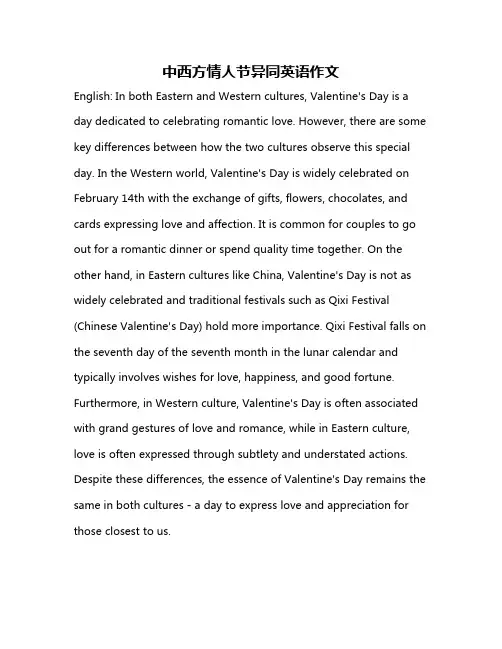
中西方情人节异同英语作文English: In both Eastern and Western cultures, Valentine's Day is a day dedicated to celebrating romantic love. However, there are some key differences between how the two cultures observe this special day. In the Western world, Valentine's Day is widely celebrated on February 14th with the exchange of gifts, flowers, chocolates, and cards expressing love and affection. It is common for couples to go out for a romantic dinner or spend quality time together. On the other hand, in Eastern cultures like China, Valentine's Day is not as widely celebrated and traditional festivals such as Qixi Festival (Chinese Valentine's Day) hold more importance. Qixi Festival falls on the seventh day of the seventh month in the lunar calendar and typically involves wishes for love, happiness, and good fortune. Furthermore, in Western culture, Valentine's Day is often associated with grand gestures of love and romance, while in Eastern culture, love is often expressed through subtlety and understated actions. Despite these differences, the essence of Valentine's Day remains the same in both cultures - a day to express love and appreciation for those closest to us.中文翻译: 在东西方文化中,情人节都是一个专注于庆祝浪漫爱情的日子。
中外节日差异作文英语英文:As someone who has experienced both Chinese and Western holidays, I can say that there are some significant differences between the two.Firstly, Western holidays tend to be more individualistic, while Chinese holidays are more family-oriented. For example, Christmas is often celebrated with close friends and immediate family members, while Chinese New Year is a time for extended family members to come together and celebrate.Secondly, the way holidays are celebrated is often different. For instance, Western holidays usually involve gift-giving and feasting, while Chinese holidays often involve rituals and traditions. For example, during Mid-Autumn Festival, it is customary to eat mooncakes and admire the full moon.Lastly, the meaning behind the holidays can also differ. Western holidays often have religious or historical significance, while Chinese holidays are often tied to the lunar calendar and agricultural traditions. For example, Thanksgiving in the US is a time to give thanks for the blessings of the year and the harvest, while the DragonBoat Festival in China is a time to commemorate the deathof a patriotic poet.中文:作为一个经历过中国和西方节日的人,我可以说这两者之间有一些显著的差异。
中西节日对比英语作文120字英文回答:Chinese and Western festivals are two differentcultural traditions that have evolved over centuries. While they share some similarities, there are also many differences between them.One of the most obvious differences between Chinese and Western festivals is the way they are celebrated. Chinese festivals are typically celebrated with large feasts, fireworks, and other traditional activities. Western festivals, on the other hand, are often more focused on family gatherings and religious observances.Another difference between Chinese and Westernfestivals is the time of year in which they are celebrated. Chinese festivals are typically celebrated according to the lunar calendar, which means that they fall on different dates each year. Western festivals, on the other hand, aretypically celebrated according to the Gregorian calendar, which means that they fall on the same dates each year.Finally, Chinese and Western festivals have different origins. Chinese festivals are often rooted in ancient Chinese mythology and tradition, while Western festivalsare often rooted in Christian or other religious traditions.中文回答:中文回答:中国和西方节日是历经数个世纪发展演变而来的两种不同的文化传统。
OECD says Unemployment Will Continue to RiseOECD:工业化国家失业率持续攀升Despite reports that many industrialized economies are beginning to emerge from their worst economic crisis in decades, unemployment is rising and will likely reach a historic peak of nearly 10 percent next year. The findings come from the Organization for Economic Cooperation and Development in Paris.经济合作与发展组织星期三报告说,工业化国家的失业率仍在增加,而且有可能在明年达到近10%的历史最高水平,尽管不断有报道说,很多工业化国家正在走出几十年来最严重的经济危机。
Indications that unemployment continues to rise is grim news for leaders heading to the G-20 summit in the United States next week. The Paris-based Organization for Economic Cooperation and Development reports unemployment reached its highest level among industrialized nations of 8.5 percent in July.对于下个星期到美国出席20国集团峰会的各国领导人来说,失业率继续上升真是个坏消息。
总部设在巴黎的经合组织说,工业化国家的失业率已经在今年7月份达到8.5%的最高水平。
Cultural Differences between China andForeign CountriesIn the vast and diverse global landscape, China stands out as a unique cultural entity, distinguished by its rich history, profound traditions, and distinctive values. In contrast, Western cultures, particularly those of Europeand the United States, exhibit their own set of distinct characteristics. This essay delves into the intricate differences between Chinese and foreign cultures, exploring various aspects such as social norms, communication styles, values, and festival celebrations.**Social Norms and Behaviors**Chinese culture is deeply rooted in Confucian values, emphasizing respect for elders, hierarchy, and collectivism. In social interactions, Chinese people tend to be formaland polite, with a strong emphasis on maintaining harmonious relationships. On the other hand, Westerncultures tend to be more individualistic, emphasizing freedom, independence, and competitiveness. Social interactions in Western countries are often more casual andstraightforward, with a focus on direct communication and efficiency.**Communication Styles**Chinese communication is often indirect and implicit, with a strong emphasis on nuance and context. People tendto use euphemisms and avoid direct confrontation, favoringa conciliatory and harmonious approach. In contrast, Western communication is more direct and explicit, with a preference for clarity and openness. People in Western cultures tend to value directness and honesty, often communicating their thoughts and feelings without much ambiguity.**Values and Beliefs**Chinese culture is deeply influenced by Confucianism, Taoism, and Buddhism, which强调仁爱、和谐、自然和内在修养。